|
| |
| Guide to the sights of the City of Neuchâtel |
|
|
|
|
| |
| |
|
|
| |
|
  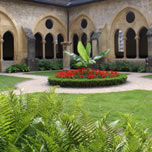 |
Located on a hill overlooking the town of Neuchâtel, the castle is the seat of the canton administration and one of the major sights in the region. If you follow the steep street (Rue du Chateau) and stairs that lead up to it, you will find yourself facing the southern castle walls, in front of the triple-jettied “Phillip of Hochberg” gallery that was erected upon an extension of the curtain wall. Under the windows, the coats of arms of 12 cantons of the Old Swiss Confederacy are displayed, as this part of the castle was built in the 16 th century when they occupied Neuchâtel for some years. Visitors can follow a circuit through the castle grounds (accessible to the public from Rue de la Collégiale) which first leads to the western part – a rare example medieval profane architecture in Switzerland. The castle consists of numerous parts, built from the 12 th to the 19 th century (some elements, like the foundation of the Prison Tower, are probably even older).
Free guided tours of the castle are offered from April 1 st through September.
Starting time: Monday and Tuesday at 10 am, 11 am, 12 am, 2 pm, 3 pm and 4 pm
On weekends and holidays tours start at 2, 3 and 4 pm.
Meeting point is the reception at the main entrance gate. |
|
|
|
|
| |
|
|
| |
| The Collegiate Church and the Cenotaph |
|
   |
As the church gives an impressive testimony of the transition from Romanesque style, manifest in elements like the column capitals, to Gothic style, experts reckon that the construction of the church proceeded slowly, stretching from the end of the 12 th (three Romanesque apses from 1185) until the middle of the 13 th century (transept and ribbed vault). The Collegiate Church was consecrated in 1276. Another remarkable feature is the South gate, guarded by St. Peter and St. Paul. The upper part of the church tower was rebuilt in 1868, but the base is of Romanesque origin.
Composed of the Greek words “kenos” (empty) and “taphos” (tomb), a cenotaph of the Collegiate Church would be an empty tomb; in fact, it is a kind of memorial depicting a group of people, carved in stone and painted. It was commissioned by Count Louis in 1372 in honor of his parents and other members of his entourage (Louis stand in the middle, surrounded by his three wives). The recumbent figures whose heads rest on stone pillows are Count Louis’ parents (Count Roland of Neuchâtel and Eleanor of Savoy), probably the occupants of a former tomb at this site.
Free organ concerts on 12 Friday nights “Les 12 vendredis” - info |
|
|
|
|
| |

|
|
| |
|
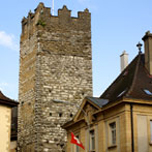 |
The oldest building of the town was constructed in several phases. The foundations of the Prison Tower go back to the 10 th century, but the big stone blocks probably had been used before, maybe even in a structure from Roman times.
The Prison Tower is open for the public from April through September, 6 am to 6 pm. At a turnstile, visitors have to pay 1 CHF each to admire a splendid view of the town and the Alps, identifying the summits of the mountain panorama with the aid of an information board. Inside the tower, two city models of Neuchâtel allow a better understanding of how the town developed from the 15 th to the 18 th century.
|
|
|
|
|
| |
|
|
| |
| The Banneret Fountain and Diesse Tower |
|
 |
Originally, the Banneret Fountain was the oldest existing well outside the primitive town fortifications (of which Diesse Tower is a remnant) used for watering horses and cattle. In 1581 it was redesigned by Laurent Perrenoud as we see it today. The figures are painted in a polychrome style that is very typical of Renaissance sculpture. The figures of the banneret and Justice as well as the market hall (Maison des Halles) are works of Perrenoud.
Other Renaissance fountains in Neuchâtel :
-
the Justice fountain (1547) on Rue de l'Hôpital
-
the Griffin Fountain (1668) on Rue du Château
And also the fountains on Rue des Boucheries and on Rue du Neubourg.
|
|
|
|
|
| |
|
|
| |
| The Market Square and the Maison des Halles |
|
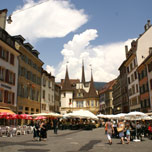   |
Once the farmers coming from the cantons of Berne, Vaud and Fribourg to sell fruit and vegetable in Neuchâtel (where they were called "marmets") could get by boat directly to the marketplace, which then lay on the lakeside.
Today, the colorful market (especially on Tuesdays and Saturdays) is a good place to enjoy delicate fragrances and pristine flavors, to try and buy local products. Or simply watch the locals do their shopping or relax one of the finest terraces of town. The most gracious building of the old town doubtlessly is the market hall, Maison des Halles. Around 1570, Laurent Perrenoud built this architectural gem on ground won from the lake as a warehouse.
The most valuable market goods were stored here – on the first floor, cereals and, on the second, cloth, drapery and Indian fabrics. Don’t miss to admire the details of the façade, e.g. the coat of arms of the Orléans-Longueville. |
|
|
|
|
| |
|
|
| |
|
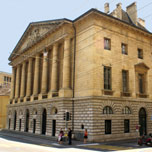 |
The town hall, finished in 1790, is a neo-Classical building with a Palladian influence. On the eastern frontispiece Minerva and Justice can be seen, framing a blazon with the town’s coat of arms, while the western side is adorned with two winged female figures symbolizing commerce and wealth. The building’s great hall is open to public and often used for temporary exhibitions. Besides, a town model of 18 th century Neuchâtel is displayed in the corridor leading to the ceremony and wedding hall on the second floor.
|
|
|
|
|
| |
|
|
| |
| The Pier and Port of Neuchâtel |
|
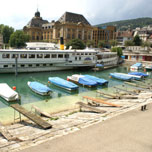  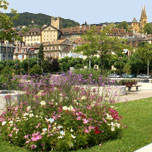 |
The history of Neuchâtel is closely linked with the lake, which has always been an invitation to establish commercial contacts across its waters, but at the same time put a barrier to the growth of the town, situated at the foot of the Jura mountain range. Since the Middle Ages, Neuchâtel has won territory from the lake, the town center moving ever further away from the lakeshore. Today, the new riparian areas contribute to Neuchâtel’s quality of life offering space for relaxation and recreation, like walking or cycling (Quai Ostervald), and cultural events, besides several new beaches – the immensely popular “Jeunes Rives” (young shores).
The port of Neuchâtel was relocated and its facilities modified several times, due to the expanding town as well as to the Jura water correction project (during the first stage from 1868-78, the lakes’s water level was lowered almost three meters). From Neuchâtel you can embark on a cruise or hire a pedal boat (pedalo) to set out on the lake. Pass by the tourist office, housed in the Hôtel des Postes, the former post office building in front of the port. On its walls, you can read the names of all countries that were members of the old Universal Postal Union, founded with the collaboration of a Neuchâtel citizen – Eugène Borel, member of the Swiss Federal Council.
|
|
|
|
|
| |
|
|
| |
|
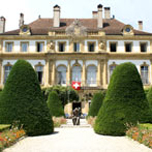 |
The palace-like Hôtel DuPeyrou gives an example of Prussian influence on Neuchâtel history. Erected from 1764 to 1771 for Pierre-Alexandre DuPeyrou, a friend of Jean-Jacques Rousseau, the splendorous private residence is a proof of its owner’s fortune. Rousseau sought and was given refuge in Neuchâtel, then under the rule of Frederick the Great of Prussia whom he was friends with. The mansion originally lay on the lakeshore; the former greenhouse or orangery can be seen left of Ruelle DuPeyrou and the old outbuildings at the rear are still standing, too. These so-called Communs (former kitchens, stables, etc.) today house the Gallery of History, a fascinating exhibition open Wednesday through Sunday, from 1 pm to 6 pm (info).
The restaurant opens from Tuesday to Saturday.
|
|
|
|
|
| |
|
|
| |
|
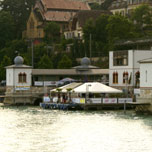 |
Dating from the end of the 19th century, the “Bains des dames” was originally a public bath house for women and children. The building’s horseshoe shape screened the bathers from prying eyes, while offering a comfortable access to the lake. Since its renovation in 2006, a restaurant called “Les Bain de Dames” occupies most of the original building. The popular place is perfect to spend a nice summer night on its terrace (reservations under +32 721 26 55).
The building also houses the water-skiing club “Ski Nautique Club Neuchâtel” that offer a quick introduction into water-skiing in 12 minutes (at the price of 30 CHF). |
|
|
|
|
| |
|
|
| |
| Maison du Prussien and the Vauseyon Gorge |
|
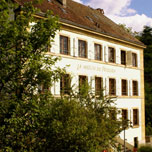  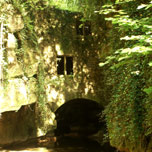 |
To round off this introduction to the main sights of Neuchâtel, we want to present a natural site, related to industrial history, that lies almost on the outskirts of town, but is nonetheless surprising and impressive – the Maison du Prussien (house of the Prussian) and the mills of Gor du Vauseyon, the gorge of the river Seyon.
Right in the middle of the industrial area of Vauseyon, in the rear of the valley leading to the center of Neuchâtel, lie the deep gorges of the Seyon river, an oasis of peace and green that conceal a historic testimony unique in Western Switzerland. In 1537, a first mill in the Gor du Vauseyon was built and more were to follow. Most mills were used until the end of the 19 th century. The house “of the Prussian” – a brewery and tavern – was erected in 1797. After a period of almost complete abandon, the building was renovated and opened again in 1985 as high-category restaurant and romantic hotel, run by Chantal and Philippe Graef. Apart from that, a private foundation (Fondation Les Moulins du Gor) has initiated measures to restore the old technical structures of the mills and make the area accessible through a network of paths and footbridges. Thanks to these activities, it is now possible to explore this beautiful natural site and even go inside the “Chambrier” mill, which sits astride the river gully. In the gorge, there is also a climbing wall, and a hiking trail that leads to the scenic castle of Valangin (Château de Valangin – absolutely recommended).
To get there, take bus no. 1 in direction of Cormondrèche and get off at the stop “Beauregard”. Now follow on foot, heading for the back of the valley. After crossing the main road via the pedestrian underpass, continue walking toward the rear of the valley. Watch out for the biggest building on the right, beside which you see a parking lot; the Maison du Prussien is right next to it.
|
|
|
|
|
| |
|
|
| |
| More monuments and other interesting places to visit |
|
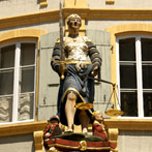   |
Just a few more lines about other places we recommend to visit during your stay in Neuchâtel.
The nicest streets (shops and cafés) are Rue des Chavannes (a steeply rising street that has a colorful fresco painted on the ground on its whole length), Rue des Moulins (old façades, fashion stores and a lively student atmosphere) and Rue de l’Hôpital (with the big department stores). The entire town center of Neuchâtel is a pedestrian area; to discover all of its charming sides you should also venture into the narrow streets and alleyways. The Temple du Bas, a temple built for the Huguenots after the revocation of the Edict of Nantes (1685), is an excellent example for austere church architecture of the Calvinist Protestants. The Passage des Corbels on Rue du Trésor hides a singular architectonic feature – an exterior spiral staircase from around 1600. Place Pury is the hub of Neuchâtel’s public transport system (TN) and the station from where the streetcar to the wine village of Auvernier leaves. Or set out from Place Pury on a walk toward the lake and along the shore until you reach the Maison du Maître on Esplanade Léopold-Robert (housing the Museum of Art and History), the Quai Ostervald and the former grammar school Collège Latin.
|
|
|
|
|
| |
|
|
| |
Should you have any comments about these presentations or like to see another sight included, please write to us. You may as well send your own text to put on our site.
|
|
| |
| Folowing: Neuchâtel, a region with a wealth of cultural and natural treasures |
|
 |
To introduce the canton of Neuchâtel, we take a trip to the countryside. It is just an ideal resort for those who want to spend their holidays close to nature and get to know the traditional heritage of a region. Ecological & rural tourism and sports activities are the strong points of what the cantons of Neuchâtel and Jura have to offer.
For example: Hike in the Natural Reserve of Creux-du-Van
|
|
|
|
|
| |
|
|
| |
|
|
| |
|
|
 |
|
 |
|
|




